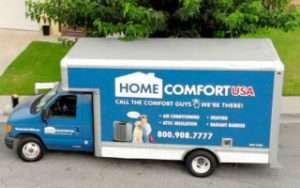When it comes to replacing your air conditioning system, there are many factors to consider beyond just keeping your home cool. As a homeowner in Southern California, it’s important to take into account the environmental impact of your AC system, as well as its energy efficiency. By making informed choices about your AC replacement, you can not only reduce your carbon footprint but also lower your energy bills in the long run. In this blog post, Home Comfort USA will explore the environmental considerations for AC replacement, including energy efficiency, refrigerant types, SEER standards, BTUs, and the pros and cons of central air conditioning, ductless mini splits, and window units.
The Importance of Energy Efficiency in AC Systems
Navigating the world of AC systems might feel overwhelming, but homing in on energy efficiency can be your compass towards making a sustainable choice. An air conditioning system that’s kind to both the planet and your wallet? That’s the beauty of opting for an energy-efficient model. These systems are the superheroes of the AC world, requiring less power to cool your home, which means they have a gentler impact on the environment. Plus, they’re kinder to your bank account over time.
Let’s break it down a bit: energy-efficient AC systems achieve their status through advanced technology and design improvements. This includes features like programmable thermostats and variable speed motors that adjust cooling output to exactly what you need, avoiding the waste of energy and money. It’s about delivering comfort without excess.
For example, Energy Star certified AC units meet stringent efficiency standards set by the EPA. These systems are designed to provide the cooling comfort you need using less energy, which is exactly what our planet and your budget require. And while the upfront cost might be a bit higher, the long-term savings on energy bills can be significant, making it a smart investment for your future and the environment’s. Remember, efficient cooling doesn’t just happen; it’s a choice that benefits everyone. Ask your Home Comfort USA AC professional about the options that would best suit your needs.
Understanding Refrigerant Types and Their Environmental Impact
Diving into the world of air conditioning, the topic of refrigerants quickly surfaces as a critical environmental consideration. Think of refrigerants as the lifeblood of your AC system, vital for cooling your home but with varying degrees of impact on the planet.
Historically, some common refrigerants have been environmental villains, contributing to ozone depletion and global warming. However, as awareness grows and regulations tighten, the shift towards more planet-friendly options like R-410A has gained momentum. These newer refrigerants are designed to leave a lighter footprint on the earth, offering a significant improvement over their predecessors.
It’s a complex landscape, but understanding the role of refrigerants is a crucial step in making choices that align with a healthier environment. As you navigate your AC replacement, asking your Home Comfort USA professional about the type of refrigerant in potential systems can make a real difference, not just for the air in your home, but for the atmosphere we all share.
Decoding SEER Standards and BTUs for Your Home
Navigating the world of SEER (Seasonal Energy Efficiency Ratio) standards and BTUs (British Thermal Units) might seem like diving into a pool of acronyms, but these are crucial when picking out your new AC system. SEER is a measure of how efficiently your air conditioner converts electricity into cooling power over an entire season. The higher the SEER rating, the more efficiently the unit operates, which translates into less energy used and more savings for you. In the U.S., new air conditioners are required to have a SEER rating of at least 14, but going for a unit with a higher SEER rating can significantly increase energy efficiency.
On the other hand, BTUs are all about size – not too big, not too small, but just right for your home. It’s the Goldilocks principle of air conditioning. A unit with too many BTUs will cool your home too quickly without properly dehumidifying the air, while a unit with too few BTUs will struggle to cool effectively, ramping up your energy costs. The perfect BTU capacity for your home depends on factors like square footage, ceiling height, and even how much sunlight your space receives. The AC pros at Home Comfort USA can give you expert guidance on what to look for.
Getting these two aspects right is key to ensuring your AC not only keeps you cool but also works smarter, not harder. This means a comfortable home for you and a happier planet thanks to reduced energy consumption.
The Environmental Pros and Cons of Central Air, Ductless Mini-Splits, and Window Units
Choosing the right AC system for your home involves weighing the environmental pros and cons of central air, ductless mini-splits, and window units.
Central Air
Central air conditioning offers the benefit of cooling your entire home efficiently and uniformly, but it requires ductwork which can be a source of energy loss if not properly sealed and insulated. On the bright side, technological advancements have made newer central AC models more energy-efficient than ever before.
Mini-split Systems
Ductless mini-splits, on the other hand, stand out for their high energy efficiency and the ability to cool specific zones in your home. This means you can cool only the areas you’re using, which conserves energy and reduces your carbon footprint. However, for larger homes, the initial setup might require multiple units to cover the entire space, which can increase the upfront cost.
Window AC units
Window units are a go-to for their ease of installation and affordability. While they can be less energy-efficient compared to central and mini-split systems, choosing an Energy Star-rated model can mitigate some of these concerns. They’re ideal for cooling single rooms or small spaces, but they might not be the most efficient choice for cooling larger homes.
Each system has its merits and considerations. Home Comfort USA can guide you to the right choice, depending on your specific home layout, cooling needs, and environmental priorities.
How Environmentally Friendly AC Systems Can Lower Energy Bills
Embracing an environmentally friendly AC system is not just a win for our planet—it’s a smart move for your wallet too. With high SEER ratings and cutting-edge energy-efficient technologies, these systems consume less energy, translating into lower monthly energy bills for you. Imagine the joy of watching your utility costs shrink, all while knowing you’re making a positive impact on the environment.
Regular tune-ups and embracing features like programmable therapeutics add another layer of efficiency, optimizing your system to work only when you need it. This way, you’re not just saving money; you’re also extending the lifespan of your AC, maximizing your investment in sustainable living. It’s about creating a comfortable home in the most eco-conscious and cost-effective way possible. So, as you consider the shift to a greener AC option, remember the ripple effect of benefits that follow, from reduced energy use to significant savings on your cooling expenses.
The Critical Role of Professional Installation and Maintenance
Ensuring that your AC system is correctly installed and maintained is akin to laying a solid foundation for a house; it’s what keeps everything running smoothly and efficiently for years to come. Opting for Home Comfort USA’s professional installation sidesteps the pitfalls of incorrect setup, which can not only diminish the efficiency of your unit but also potentially shorten its lifespan, leading to unnecessary expenses.
Moreover, regular maintenance by a qualified HVAC technician can help identify and rectify minor issues before they escalate into major problems, ensuring your system remains in top condition. This proactive approach maximizes the efficiency of your air conditioning, further reducing its environmental footprint while safeguarding your investment.
With professional expertise from Home Comfort USA, your AC system is more likely to operate at its peak, offering optimal cooling without wasting energy.
Consulting with an HVAC Professional: Your Next Steps
Embarking on the journey of replacing your AC unit brings with it a maze of choices—from selecting the most energy-efficient model that suits your home’s size to understanding the intricacies of SEER ratings and eco-friendly refrigerants. It’s here that the expertise of an HVAC professional from Home Comfort USA becomes invaluable. Our seasoned specialists can demystify the process, helping you navigate the myriad of options available, ensuring that your choice not only aligns with your environmental values but also fits your specific cooling needs and budget.
A consultation with a Home Comfort USA HVAC expert offers a tailored assessment of your home, factoring in the unique aspects that affect cooling efficiency, such as layout, insulation, and local climate. They’ll guide you through the benefits of different AC systems, whether you’re considering the uniform cooling of central air, the targeted approach of ductless mini-splits, or the simplicity of window units. With our insight, you can weigh the pros and cons, making a decision that’s not just good for the planet but is also practical for your living space.
Moreover, Home Comfort USA’s HVAC professionals can oversee the installation process, ensuring your new system is set up correctly from the get-go. This is crucial for maximizing the unit’s efficiency and longevity, helping you achieve those lower energy bills and reduced environmental impact you’re aiming for.
In short, professional guidance is the key to unlocking a cooler, more sustainable home environment. Give Home Comfort USA a call or book an appointment online today!






